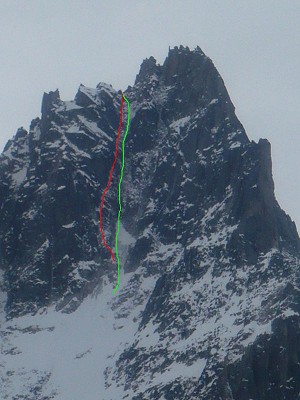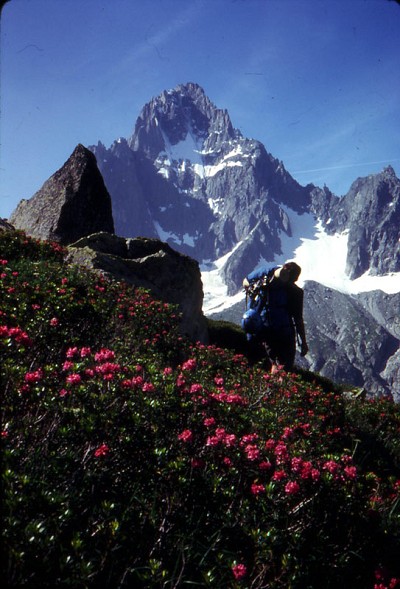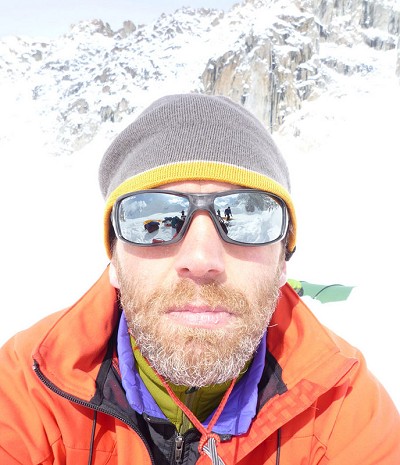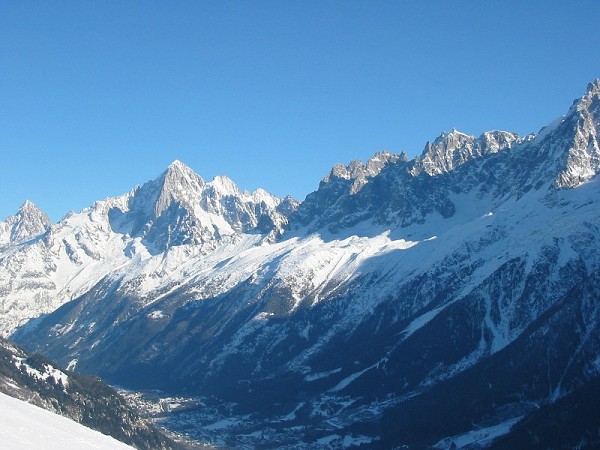

At first I just wanted anything to take my mind away. The normal things in life. Drink, work, women, drugs - in no particular order. But I knew I'd return, nothing could replace the masochistic pleasure of mountaineering.
Slowly the urge returned and here I was, walking towards Nameless Cwm, nothing too serious, just a circuit over the Glyders to ease back in and reconnect with the mountains. There was a cold wind and the ground lay thick with new snow, if I'd been climbing it would have been a great day for it.
As I walked up into the cwm a sudden roar caused me to instinctively cower down in fear, “Oh no not again” I thought, as I scanned the slope above me, before I realized it was just the sound of the wind. I felt like a traumatized soldier hearing a car backfire.
The recovery process would take some time.
Nine months earlier.
After a great Scottish winter season living in Aviemore, we were looking forward to spending the summer in Chamonix. We left Scotland around mid April and after a two week climbing trip around the south west – Bosigran, Chair ladder, Sennen, Pentire head, ticking as many classics as the weather would allow - we threw our mountain kit in the bag and set off.
The coach trip dragged by as usual but you can't argue with the cost, as every pound saved equalled potential routes climbed. We planned on being there as long as possible, so all spends were kept to a minimum. We were staying in the old ski jump building and stashing our spare kit in the woods to save on campsite fees.
It was early June and we were chomping at the bit.
Conditions were typical for this time of year, not quite cold enough for the ice routes to be in great condition but too much snow on the rock. After four days of low cloud and drizzle the frustration levels were building. Each day consisted of weather forecast checking, guidebook reading and route debates. But things were looking up; the forecast suggested in two days, we would get one day of slightly clearer skies with no precipitation. Not ideal but hopefully good enough to get something done.
During our hours of guidebook reading we'd come across the north face of the grand Charmoz. A great idea, with a guidebook time of ten hours for the route, this would work out perfectly.
The plan was hatched: Day one, approach in the bad weather and bivvy somewhere near the start of the climb. Day two, climb the route, rap off down the western side and beers in Cham.
The problems started on the approach.
The guidebook mentions a recent landslide on the traverse from Montenvers but we soon found ourselves climbing between slide alder covered in snow and 80° mud, hanging on to the old wires that had marked the path with our hands. This was tiring work and it took us the best part of the day to reach the face.
It was five o'clock by the time we'd set up a bivvy, about a hundred metres down from the start of the route, slightly protected by a small spur on the right hand side, and after food and brews, the slog to get there was fading to a distant memory. We were back on track.
Small stones falling from the rock wall above us were slightly disconcerting in the night and these, along with the thousands of scenarios playing out in my mind, meant that sleep was hard to come by, but at five in the morning we were ready to go, and before long, had reached the start of the route, a steep snow filled corner.
The temperature was about one degree above zero, but the decision was made to continue on the basis that it was likely to be freezing higher up, and anyway who wants to turn back without even giving it a go. In hindsight most epics can be traced to seemingly small decisions that pile up upon each other - any one of which could change the outcome - and this was probably the first.
The snow was unconsolidated and slow work but the thought that things would improve further on kept us going. The first pitch was vertical snow in a chimney, I pushed my arms straight in to make upward progress and after about twenty metres arrived sweating and out of breath at an easier angled section. The route went rightwards from here over rock steps with more loose snow that needed clearing to make any progress. The route wasn't obvious and we were going slowly as we tried to find the best line, but things weren't improving and at this rate we wouldn't get to the top today and would need to look for a bivvy.
I moved left into a gully that led up to the median ice field. Wow good ice. That must bode well for the exit gully. Things were looking up again. So what if we didn't get up it in guide book time. It's all part of the alpinists apprenticeship. We could analyse where we went wrong over a beer when we got down.
At the top of the gully on the left, was a boulder projecting from the snowfield, it was the only opportunity for a ledge and after about an hour of hacking we had a seat for the night. For some reason I can't remember, we'd decided to take one bivvy bag and one sleeping bag between us. We sat down, backs against the rock, feet in rucksacks, the sleeping bag rapped around us and the bivvy bag over our heads. Not great but it should do.
The stove had been going for a couple of minutes when the spindrift started. The first slide left about a foot of snow around us. The stove was buried. After digging it out, Steve fired it up again, only for more spindrift to hit two minutes later. There would be no hot food or drinks tonight.
It was impossible to sleep. Every time the spindrift came it would get between us and the rock slowly pushing us off the ledge.
At two o'clock we'd had enough. We were getting too cold just sitting there and we needed to move. We forced ourselves into action. Slowly we moved up the snow slope - stopping every time the spindrift poured around us - until we reached the start of the upper couloir.
This section started at about seventy degrees and looked great; I hit my axe into the ice and felt it rip through easily. I tried again, no difference, my axe went in about three inches, hit rock and ripped, there was no way we'd get up that.
To the left of the ice it looked feasible to climb up on mixed ground, keeping under the steep sidewall of the gully all the way. Steve started up.
Crampons scraping, teetering up, axes and feet on tiny rock edges, I waited for the fall, but it never came, he was up. After the first five metres of steep climbing it eased off and became less technical, but clearly the five or so pitches of mixed ground would be a lot slower than the straight forward ice gully we'd been expecting.
Tiredness was catching us up. Every belay was a fight to resist the slow drift towards sleep that would end in a jolt, and then start over again, until the rope went tight and it was time to climb. Seconding higher up, I pulled on a four foot high block and quickly moved aside as it peeled away leaving the acrid smell of cordite to awaken my mind.
Later, I looked up from my drifting world to see a light slowly falling towards me. It was Steve's head torch.
He belayed were he was, and I moved through. It was getting lighter.
I lead the final pitch rightwards up a crack in a slab buried by two feet of loose snow. This brought us out on a col to the left of the summit block, where we sat for a while gathering ourselves. It was seven in the morning; we had been on the route for twenty two hours and were knackered. Still that was less than the first ascentionists so not to worry.
After a brief look rightwards towards the summit we baled.
From the col a gully led down the east face towards the Envers hut so we started abbing. This descent was made by Mark Twight after his ascent of the north face and has since been climbed by Patrick Gabarrou (Avidya V,4+).
Three abs led to a steepening. Steve hammered a three inch knife blade into a crack on the left. It went in half way and would have to do. I leant back and watched as the peg flexed, but in this numbed state of mind, felt no fear, as if I was resigned to whatever happened.
Steve abbed and pulled the ropes. The next section was a snow slope that I started to down climb. As I neared the bottom, at the top of the lower gully, my foot kicked through to rock and slipped slightly. My left crampon had come off. The bale had snapped. It was useless.
Steve was approaching.
"Watch this bit", I said.
Too late, I looked on in horror as he started to slide, arms straight out, he was gathering speed.

In slow motion I watched him slide past me, terror in his eyes, over the edge, out of sight, then silence. It's hard to find words to describe the feeling at a moment like that but lonely, shocked, and stunned would be a start. I shouted, loudly at first, maybe he'd stopped somewhere out of sight, but then quieter as I realised the reality. It must have been two hundred meters to the burgshrund.
The ropes had been attached to Steve's harness so the only option was to down climb with one crampon on unknown ground all the time dreading what would be waiting for me somewhere below.
The first section was vertical for four meters with rotten ice, but this allowed me to kick my foot right through to get purchase. Below and slightly to the right was a small snow patch at forty degrees, if my axes pulled I could spring backwards like a cat and land on it... its funny what you tell yourself sometimes.
I was now in the lower gully. Running down the centre was a snow scoured runnel, it was the best option for descent but the action of the spindrift going down it, had turned the snow bullet hard. It took four or five kicks to get my boot to hold before moving and before long the second crampon had broken.
I couldn't believe it, what were the chances of both bales breaking at the same time.
At this point I felt as though my time was up. No longer was I in control of my destiny. But these thoughts galvanised me, I wasn't done yet. Every couple of minutes the runnel would turn into a river of spindrift between my legs as I bridged across it and waited, down climbing again when it passed.
It was late afternoon by the time I reached the bergshrund. Fifty meters below, I could see Steve. He was sitting up, moving. Unbelievable, how had he survived that?
We needed to get to the hut, it was about five hundred metres away and it was going to be hard work for Steve. He didn't seem to be in bad shape considering, no broken bones but moving was painful and he was clearly concussed.
We left his bag on the snow and he held my shoulders while I post holed across the slope. Again it was slow work making sure each foothold was properly compacted to reduce his effort. It was dark when we finally reached the refuge and even opening the door seemed too complicated for my tired mind to work out.
As soon as we were in, Steve curled up on the floor, shivering. I needed to get him warm quick. I emptied my bag on the floor, found the head torch and turned it on. Nothing, the wires were disconnected. With numb fingers, I fumbled about until the connection was made, and with the light on, I got him upstairs and covered in blankets.
It was gonna be ok.
We awoke to the sound of engines and thrashing air. Helicopter. It sounded like it was landing on top of us.
They'd probably seen Steve's bag on the snow slope and our tracks leading to the hut. The door opened and the co-pilot came in. He said something in French.
“Anglais” I said.
“Are you okay? Do you need a lift?”
I tried to explain what had happened and asked Steve what he wanted to do. It was his decision, I didn't want rescuing. After all, we only had the walk out to go. But if he wasn't up to it we'd take the chopper.
“No, I'm all right”, he mumbled from under the covers and that was that.
Later, around ten we got up. Steve's rucksack was outside, they'd picked it up, that would save me a walk.
It was a beautiful blue sky day; we could relax and sit on the terrace recovering in the heat from the sun. At around midday we were packed and roped up ready to descend, we had about twenty metres of rope out between us and the rest coiled in my pack. Looking out from the hut we moved rightwards on to the snow slope that would lead us to rocky ledges and then the glacier.
“What's it like?” I asked.
“Seems okay”.
We slowly made our way down following weaknesses through the rocks until Steve stopped for a rest, I stopped next to him. To our right facing out there was a gully.
“Look at the speed of that snow coming down there” I said.
The gully was avalanching, but it wasn't registering properly in my mind, everything had slowed down.
A roaring sound instinctively made me look up just in time to see a tidal wave of snow breaking over the rocks directly above us.
“Steeeeve!” I screamed, as I tried to flatten myself against the rock face.
Less than a second later it hit. The force was incredible, instantly I was amongst it tumbling forward, head first, then side ways, then legs first, I undid my rucksack but the rope inside it was attached to my harness and I couldn't free it. Kicking furiously I went with it, over an edge I landed in snow and slowed slightly, feeling snow piling up on my legs I thrashed to free myself, aware of the head sized rocks flying past.
Then I stopped. The rope had snagged on something allowing the avalanche to carry on, and a few seconds later it was over.
I stood up and looked. The rope had dug into a snow ridge between two runnels, I was in one and Steve was in another about five metres to my left.
I untied and staggered over to him. He was hanging from his harness, back arched, and making no effort to move.
“My back hurts, take my bag off” he said.
“You haven't got it on” it was on the slope below.
I had to do something. He couldn't stay in that position. Another avalanche could come down any minute or so I thought. But I didn't know what his injuries were. I moved back up to free the rope, then back to Steve to try to move him out of the danger zone.
Things were bad, really bad.
I put my arm under his shoulders and lifted him up slightly. He was looking at me, registering, and then, like a plug being pulled, nothing, he was gone. From being my mate and climbing partner to a body I didn't want to be around. In a state of shock I picked up my bag and moved away, there was nothing left for me to do here.

He loves all aspects of climbing and discovered the mountains in 1991. He is particularly obsessed with alpinism and Scottish winter which he does at any opportunity.
He has two boys aged 6 and 4 which provide his other reason for living.















Comments